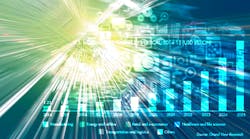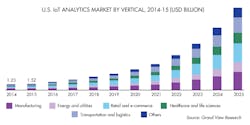Download this article in PDF format.
The exponential rate of growth in the Internet of Things (IoT) has of course led to more and more things, from wearable devices to factories, becoming embedded with technology. Consumers, as well as enterprises, are increasingly realizing the full potential of IoT, ultimately reducing cost and leveraging more robust data analytics.
Regardless of all the technological advances, end-users and businesses haven’t yet completely tapped into the vast possibilities of the IoT. One of the reasons for this is that today’s users lack the knowledge on how to collect and utilize data from the connected devices. Though it’s theoretically possible to collect and analyze more data than ever before, the actual implementation still lags behind.
There’s an ever-increasing need to think about the relationship between connected devices and the optimum utilization of data in various analytics use-cases. Companies that haven’t yet started leveraging the abundance of data are missing the IoT bus.
As per the estimations made by Grand View Research, the global IoT analytics/analytics of things market size is expected to reach USD 57.3 billion by 2025, following a CAGR of over 29% from 2017 to 2025. Increasing demand for cost-effectiveness and advanced technologies has boosted the adoption rate of analytics of things among enterprises. IoT analytics is helping enterprises and individuals gaining real-time insights, thereby optimizing the decision-making process.
The figure depicts the U.S. IoT analytics market size estimates and forecasts, broken down by various verticals including manufacturing, energy and utilities, retail and e-commerce, healthcare and life sciences, transportation and logistics, and others. Manufacturing is expected to be one of the most lucrative segments, while healthcare and life sciences will likely emerge as the fastest growing vertical over the forecast period.
A wide range of vertical markets contribute to the IoT analytics ecosystem. (Source: Grand View Research)
Developing IoT Analytics Use-Cases
Industries: Shift Toward Optimization
Manufacturing, power generation, oil & gas, and logistics & transport are becoming a perfect breeding place for IoT advancement. Most of these industries have become extensively automated, which offers boundless potential for data collection. The companies are increasingly struggling to remain competitive in the market by achieving the best results at the lowest possible costs. Businesses worldwide are looking forward to collecting more and more data by establishing a connected ecosystem.
Though many industries have automated their business processes, they still have a long way to go to fully harness the capabilities of IoT analytics. Automation has allowed the enterprises to process and ship orders faster than ever before. However, the implementation of IoT analytics in order tracking and machine performance is anticipated to help the enterprises better optimize their manufacturing and inventory processes.
The implementation of IoT can help various industries analyze the data collected from almost every single part of their inventory, manufacturing, and distribution processes, thereby reducing wastage, quickly optimizing their operations, and predicting accurate time for machine maintenance.
Smart Cities: Improving the Quality of Urban Life
The transformation toward a smart city is already on its way in many urban areas around the world. Something as simple as an electronics sign informing passengers when their bus is supposed to arrive, or giving its current running status, is an example of IoT solving problems in smart cities.
Navigation is one of the biggest hassles in megalopolises. Tracking the real-time location of trains, buses, metros, trams, and subways is expected to help commuters overcome significant difficulties related to public transportation. Moreover, municipalities can utilize this data to schedule their maintenance or repair activities for public transport and infrastructure, aiming toward the least disruptive time for work and allocating the most efficient workforce for the same.
IoT data has the potential to significantly improve the quality of life in cities, particularly where public facilities are involved. For instance, Barcelona, Spain has started utilizing sensor-equipped trash cans to help city management regulate the service routes, keep the trash can empty, and decrease traffic.
Future applications of IoT analytics in smart cities is limitless in scope. With more objects in cities becoming a part of the IoT, city planning is expected to be shaped from effective utilization of analyzed IoT data, in order to optimize public relationships with the urban environment. New bus or train routes could be strategically planned by using years of traffic data. City power grids in most metropolises have already started tracking the power consumption, so we foresee the development of solutions, such as blackout prevention, that will effectively manage city power consumption and supply.
Customer-Driven Innovation
The buzz about IoT has now become a roar in the retail industry. Retailers are increasingly leveraging the benefits of IoT to upgrade their customer experience, provide new services, and enter new markets. Data collected from IoT devices and sensors not only help retailers attain an enhanced management of energy usage and store assets, but also enhance in-store marketing efforts. IoT-delivered data provides real-time insights into employee productivity and inventory management.
The majority of the advances in the retail industry are primarily focused on the customer’s journey of selecting items through the store. For instance, several retailing giants have started utilizing smart check-out stations, which are designed to weigh, scan, and automatically complete all check-out procedures within a smart cashier-less checkout station.
All of these examples represent how the retail sector is implementing IoT analytics to enhance the customer experience by alleviating the worst parts of shopping, like waiting for items to ship or waiting in line. Furthermore, some innovative startups are working on the development of new IoT data use-cases, which are expected to reveal a better analysis of buyer interaction during the purchase process. The analysis is primarily based on the following parameters:
- How are customers moving in the store?
- How long are they in dressing rooms, waiting in queues, and/or looking at products?
- What type of difficulties do they face while shopping?
- What is influencing them to move to brick-and-mortar stores?
IoT Analytics Shaping Human Habits
Wearable technology is one example of how IoT analytics is being used to shape human habits. Consumers increasingly use fitness trackers and smartwatches for their self-improvement. These devices allow a user to analyze his/her behavior by tracking steps traveled, miles run, sleep, or minutes without any motion.
The advent of IoT in the human ecosystem has led to the development of smart refrigerators, allowing users to remotely check the inside of the fridge (with the help of interior cameras) and notify them when food is about to expire. We believe that it’s only a matter of time before a smart fridge will be developed that would be able to precisely track the way a user eats, wastes, and buys food.
Personal betterment with IoT is simply the process of automatically collecting the behavioral data and using it to modify the way an individual behaves. Increasing sophistication of wearable devices is likely to support the trend, i.e., self-improvement with IoT. With many consumer/individual items becoming a part of the IoT system, market incumbents are expected to stay focused toward optimizing the utilization of IoT data.
Intersecting IoT Analytics with Connected World = Huge ROI Potential
Be it improving machine behavior, or resource management, or enhancing personal routine, IoT analytics has the potential to significantly revolutionize the way we achieve our goals. The intersection of IoT analytics with the web of things will likely open the door to myriad business opportunities.
Grand View Research predicts there will be almost 100 billion devices connected to the internet by 2025. These include everything from smart-home devices to industrial equipment and critical machine tools to driverless cars. The growth in the IoT devices is anticipated to lower the cost required to embed almost any item with a sensor and permit real-time transfer of the data collected from sensors over cellular, wireless, or other networks.
Siddharth Misra is Senior Research Analyst, Information, Communication, and Next-Generation Technologies, at Grand View Research.


